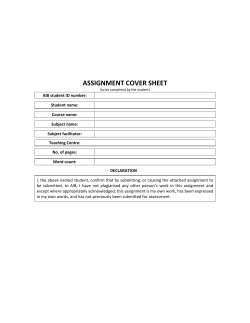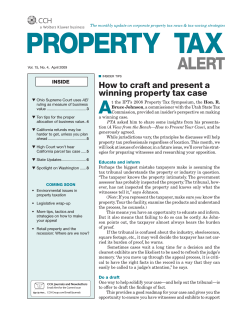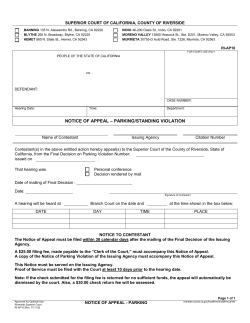
appeal how to effectively
Date Name, Address, Telephone To the Board of Review/Tax Tribunal: I wish to appeal my property tax assessment for the following reasons: 1. According to my Worksheet/Property Record, I have noted the following discrepancies: A. I do not have a fireplace as indicated. Estimated value........................................................... $1,800 B. I do not have a tile bath as indicated. Estimated value........................................................... $1,200 C. According to my worksheet, I have 1,500 square feet of living space. I have 1,000 square feet. Reduced value............................................................$6,920 This amount should be deducted from true cash value..........$9,920 2. I have noted the following structural defects on my property. They reduce the value of the property by the following amounts. A. Cracked foundation.................................................... $3,800 B. Cracked exterior wall.................................................. $2,200 This amount should be deducted from true cash value..........$6,000 3. I live in an area that has mixed zoning and next door there is a new junkyard which emits loud noises and noxious odors. This affects the value of my property. I feel my true cash value has been reduced by................................................................ $3,000 3a. Grand Total, add 1, 2, and 3 above............................ $18,920 4. I wish to make the following comparisons: 231 Main Street, assessed value _______________ (List all comparables and ask for an average reduction. Also add all items you noted as discrepancies) Example: True Cash Value.........................................................$60,000 Minus Discrepancy/Grand Total................................$18,920 New True Cash Value.................................................$41,080 One Half = Assessed Value (SEV)...............................$20,540 sample letter how to effectively appeal your property tax assessment from the Home Builders Association of Greater Kalamazoo and the Greater Kalamazoo Association of Realtors Dear Property Owner, It is likely that you have recently received notice of your 2012 property tax assessment. As you review this document, you should be aware that you have right to appeal your home valuation to your local board of review if you believe it is not accurate. Your board of review if a small independent panel made up of private citizens. This panel is meeting the second week of March, and has the ability to change your assessment if they believe it contains errors or is inaccurate. Despite the weak economy, some neighborhoods may see State Equalized Value (SEV) increases that exceed the rate of inflation. This is true because state law requires the SEV to reflect 50 percent of True Cash Value for your home. Fortunately, these increases do not necessarily affect your taxes. Instead, your property taxes are calculated using “Taxable Value,” and those values are expected to decreases 0.3% percent this year because of Proposal A. This is a step-by-step guide to help you review your assessment to ensure accuracy and educate you in the appeals process. We have included the Michigan Assessors Association website so that you can locate and contact your local assessor if you would like to arrange an appointment. You should be prepared to make your case to the board using about five minutes or less. Please feel free to contact us if we can provide you any further information. Board of Review A panel of local independent citizens appointed to review assessments of taxpayers who believe their valuation is inaccurate or contains errors. Key Definitions Assessing Department The local government entity charged with creating and adjusting assessments for every parcel of property in your community. True Cash Value (TCV) The actual value of your home, as determined by the local assessor. State Equalized Value (SEV) 50 percent of the actual value of your home. Taxable Value The capped value of your home. By law, increases in your taxable value are limtied to the inflation rate or 5 percent, whichever is less. step 4 If your tentative taxable value did not decrease by at least 0.3% below your 2011 taxable value and you did not improve your home with additions, there may be an error. Call your assessor immediately and inquire as to why your taxable value increased by more than the rate of inflation. Remember, increases in taxable value that are not attributable to additions are capped at the rate of inflation or 5%, whichever is less, until the property transfers. SEV is not capped, but must reflect 50% of your property’s true cash value (TCV). Either taxable value or SEV may be appealed to the Board of Review. Make sure that a Homestead (principal residence) Affidavit has been filed for your homestead. If you filed a Homestead Affidavit last year, you do not need to file a new affidavit this year unless you moved. Call your assessor if you have specific questions. As noted in Step 2, the “percent good” is the way an assessor depreciates the value of a home based on its age. For this reason, normal issues common to all homes of that age are not considered in the specifics on the assessment. however, many homes have problems that are not associated with general aging. Examples might be cracked foundations, wall construction problems, or poor masonry work. The impact of these problems on the value of the home should be specifically addressed. Therefore, it is necessary to perform a complete inside inspection of your home. Written repair estimates and photographs of structural damage are very good evidence of defects which could affect property value. If you live near a major road, landfill, business, or industry, your home may be less desirable than the same home located in a purely residential neighborhood. You may live in a mixed zoning area which includes commercial, industrial, and residential property. You may have a well, septic system, or dirt road. Obtain copies of citizen complaints about area drug houses, rowdy party homes, and neighborhood eyesores. Tape record factory, truck, or party noise. If these characteristics have changed, they may contribute to a deteriorating value of your home and you should be able to show this to the board. If you recently purchased or refinanced your home, determine whether your purchase price or your appraisal is lower than your assessment. Providing this documentation to the Board of Review is not a guarantee, but will help strengthen your case. One of the most common mistakes home buyers can make is that they fail to inform the assessor of personal property and other valuable items which were included in the sale. Personal property items often included in a home’s sale price, such as furniture, curtains, washer, dryer, etc., are exempt from assessment. If you do not inform your assessor in writing about these items, your assessment may erroneously includethis value. 5830 Venture Park Drive Kalamazoo, MI 49009 (269) 382-1597 Phone (269) 382-3462 Fax www.gkar.com step 8 The assessor may agree to change some of the information or figures at that time, or you may have to make your case with the local Board of Review. There should be a “percent good” calculation on your worksheet which shows you how much your house has depreciated. Usually the Michigan Assessor’s Manual requires that every property have a “percent good” calculation. If your house is ten years old, it will be about 90% good. Percent good is another factor to use when comparing your home with other homes (see #4) Location is the single most important feature which determines the value of your home. step 9 Carefully check the worksheet for errors. step 5 Go to your local assessor’s office and obtain a copy of your worksheet or appraisal card for your property. This should list the size of your house, the type of construction, special features, etc. The worksheet contains other information such as style (ranch, colonial, contemporary, etc.) of your home, utilities, construction date, number of baths, fireplaces, and kitchen range hoods. Ask the assessing department to explain the document until you completely understand the abbreviations and numbers. You can also obtain worksheets of similar properties which recently sold in the area which the assessor is using to determine the value of your property. step 6 You may appeal either your taxable value, SEV or both to the March Board of Review in 2012. step 7 step 3 step 2 step 1 Comparable property assessments are one of the most important tools for a property tax assessment appeal. If comparable properties are assessed lower than yours, you may argue that your property is overassessed. Make your comparable study by asking for the worksheets of similar homes which have recently sold in your area. Check the assessed value, the state equalized value, taxable value, type of house, and zoning. Compare the TCV per square foot for these homes. Keep in mind that these comparisons should be made between similar homes (i.e., compare two stories with two stories, or ranches with ranches.) The last step in the process is to put all your information into letter form. See the Sample Appeal letter on the back page of this guide. Please note: this sample letter indicates many of the grounds for a reduced assessment. It is very unlikely that an assessment could be reduced by nearly one-third, as illustrated by the Sample Letter, but every reduction is important. To get the contact information for your municipality’s assessor, please visit the Michigan Assessors Association website: www.maa-usa.org or contact your local municipality’s office. not satisfied? If you are not satisfied with the decision of your local Board of Review, you may want to continue your appeal. In order to appeal the decision, you must send a letter to the Michigan Tax Tribunal, P.O. Box 30232, Lansing, MI 48909, on or before June 30. They will mail you the necessary forms. You must appeal to the local Board of Review before you can contest your case to the Michigan Tax Tribunal. 5700 W. Michigan Ave. Kalamazoo, MI 49009 (269) 375-4225 Phone (269) 375-6493 Fax www.KalamazooHomepage.com
© Copyright 2025





















